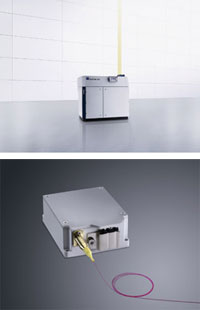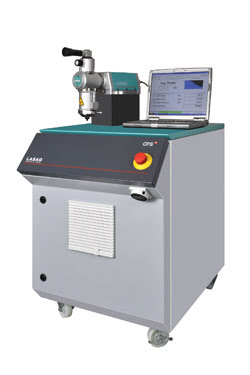At Laser Munich this year, fibre lasers emerged as real contenders.
Jörg Schwartz, E uropean Correspondent
Diode-pumped solid-state lasers have gained widespread use in industrial applications, a fact that might make you think that things have settled down with regard to new lasers entering the materials processing arena, or that vendors would be focusing on improving current lasers, or – often more importantly – that they would be improving how they meet new and current applications.
However, because lasers often displace other technologies when it comes to solving an application, there is always the question of which laser is best for a particular situation. Add to this the fact that new laser types enter the market and quickly replace others, which was in evidence at this year’s Laser World of Photonics show in Munich.
Fibre-coupled high-power diode lasers are major contenders for direct materials processing applications and have now become part of Trumpf GmbH & Co. KG’s lineup. The company says the beam quality enables it to replace current lamp-pumped solid-state lasers not only for soldering and conduction welding but also for keyhole welding and cutting.

Fibre-coupled diode modules (bottom), producing output of up to 100 W and running through a 100-μm fibre, are the core of Trumpf Inc.’s TruDiode 3006 diode laser system (top) for direct manufacturing applications. Several of these modules are combined into a laser unit to achieve the output of 3 kW, with a socket efficiency of up to 40 per cent.
Jens Bleher, managing director of Trumpf Laser- und Systemtechnik GmbH, said that, “If a customer uses our TruDisk diode laser instead of a slab laser with three-kilowatt output power, the electrical power consumption is reduced by a factor of ten.” This is obviously not only good for the environment but also for the operating costs. “Under typical three-shift production conditions, like in automotive production, a sample calculation gives a cost reduction from six euros to less than fifty cents per hour,” a result of not only the high efficiency – up to 40 per cent – but also of the long lifetime of the laser components.
Power increases
The maximum output power from diode lasers has been increasing continuously over the past few years, and the new 10-kW LDF series from Laserline GmbH, delivered via a 1-mm fibre, allows a spot site in the same order with 100-mm focusing. The lasers, intended for heavy-duty industrial applications such as cladding or welding of thick sheets, use active cooling to enable a 770 × 950-mm footprint and reach efficiencies of up 45 per cent. Otherwise, the multikilowatt power range has been dominated by solid-state and CO2 lasers for decades.
And if you thought CO2 lasers were out of business, think again. They are far from it, according to their manufacturers. Vendors including Rofin-Sinar Laser GmbH note that their instruments are simple and clever. Even those from the “solid state” camp, such as Friedrich Kilian, executive vice president of Trumpf and a speaker at the World of Photonics’ Lasers in Manufacturing Congress, predict a long period where the CO2 will co-exist with its “young and aspiring” challengers.
And, indeed, progress has been made in CO2 lasers. Coherent Inc. presented its new E-150/E-1000 models – 1500 × 500 × 400 mm, including the power supply – which provide output power of 150 W and 1 kW, respectively, for small machine applications in cutting and drilling of nonmetals. “And these lasers now come with a reliability comparable to fibre lasers – including their RF [radio frequency] power supply,” said Stuart Woods, director of business development at Coherent.
Rofin-Sinar, a leader in the industrial CO2 laser market, made a big splash about fibre lasers during the show. The company is pushing the power of its industrial fibre laser systems up to 2 kW, making them suitable for more classical cutting and welding as well as for new applications such as remote cutting. Worth noting is that it is pushing fibre lasers well into the kilowatt domain, whereas rival Trumpf currently offers 400 W and appears to be leaving the kilowatt range to its conventional, yet successful, disc lasers – at least for now.
Another turnkey materials processing vendor not placing all bets on the new horse is Lasag AG, a Swiss manufacturer of laser precision processing with either lamp-pumped Nd:YAG or diode-pumped fibre lasers. The company’s CFS series comes as a complete laser solution, incorporating 50- to 200-W water-cooled fibre lasers with high-power stability, beam delivery, customized processing optics and laser control as well as customized options for cutting and welding when making medical devices, electronics and watches.

Fibre lasers such as this water-cooled system from Lasag AG offer high power stability, beam delivery, customized processing optics and laser control. The CFS Cut was specifically designed for processing of thin-walled metallic parts such as medical stents, with a cut width of under 20 μm.
Another area where “old” and “new” argue the merits of change is laser annealing in LCD screen production and similar semiconductor processes. In this case, the defender clearly is the excimer laser, for which improvements have been made by Coherent with regard to reliability, simple operation and cost of ownership. But frequency-doubled solid-state laser makers say they can do better.
Photovoltaics targeted
A related area that drew attention at the show was lasers in photovoltaics production. For this, many manufacturing jobs are done best by lasers – edge isolation, silicon cutting, marking, drilling and thin-film removal – and in particular for thin-film solar cells, which are sensitive to mechanical handling. A variety of lasers compete for these jobs and, as usual, many parameters beyond power and beam quality must be considered, including wavelength or repetition rate and pulse width. The jury is still out on quite a few applications for this growing market, in which, unlike most others, it is not about one laser replacing the other.
In manufacturing thin-film solar cells – and in some other areas where power is needed in precisely the right spot – short-pulse and ultrashort-pulse lasers are likely to gain commercial relevance in manufacturing. They will not compete with the big guys, where power and beam quality are at the top of the wish list, but they have their sweet spot wherever small impact on surrounding areas is required, which is key to ultraprecision processing in various areas of application. Whether in medicine, electronics, aerospace or solar technology, thin coatings can be removed, fibre-reinforced plastics drilled and ceramic components’ surfaces structured.
Femtoseconds are the shortest that lasers pulse these days (see Photonics.com story on Congress opening), and most commercial short pulse lasers use picoseconds. A wider use of femtosecond lasers is limited by the costs connected with the complex optical modules required and by the average output, which is currently limited to below 100 W on commercial systems. This could change with the Fraunhofer Institute for Laser Technology ILT’s development of a 400-W femtosecond laser based on its InnoSlab technology.
Exciting progress is coming our way in lasers in manufacturing, in particular fibre-coupled, directly applied diode and fibre lasers. However, as usual in this field, even somewhat aged technologies will continue to be optimized and demanded, and various generations of lasers will co-exist for the same application.